

|

|
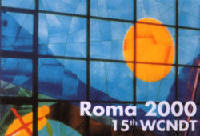 | Bond Testing and Mapping System for Concorde's Flying Surfaces K.McLaughlin, Advanced NDT Instruments - UK, Palmer, British Airways - UK, V.Moshkovich, A.Passi, G.Passi, Sonotron NDT - Israel |
- Fully objective data acquisition, storing and representing provided by:
- Mechanics-free monitoring of bond probe coordinates on the object under test
- Monitoring and on-line indicating of coupling between bond probe and object under test
- Un-violation of traditional bond probe manipulation
- On-line imaging of:
- Current bond probe location on the object under test
- Actual probe trace and breaks caused by missing of coupling
- Color-coded map of object under test
- Immediate creating and storing fully objective inspection data files
- Intelligent postprocessing of stored data provided by:
- Automatic detection and counting of defects areas and measuring their coordinates
- Printing fully objective inspection report and accompanying pages
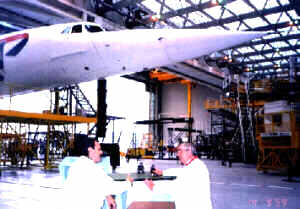 Concorde has been safely carrying passengers supersonically for many years. To ensure the continued safety, the flying surfaces are regularly inspected and monitored while "on wing" as well as when removed from the aircraft.
Concorde has been safely carrying passengers supersonically for many years. To ensure the continued safety, the flying surfaces are regularly inspected and monitored while "on wing" as well as when removed from the aircraft.
Due to the access (while on wing) and the size of the flying surfaces the engineers are faced with some practical problems. Currently a hand written inspection report is raised.To improve the quality of the reporting and have the ability to demonstrate and record a satisfactory inspection, British Airways required a system to digitally record the manual scans.
The rugged portable battery-operated computer-based ISONIC workstation ensures the validity of manual inspection. It monitors probe coupling within the area scanned and records all the results [1-4]. While ISONIC was originally developed for the inspection of metals, British Airways decided to utilize its features with their bond testing requirements, recognizing the need for a mobile system that could be quickly set up while attached to the aircraft [5].
To monitor the area scanned, ISONIC workstation uses airborne ultrasound. An operator clamps the conventional bond inspection probe into the probe holder. The transmitter of airborne ultrasound is fastened to the probe holder, and two or three receivers are placed on the object under test by means of vacuum cups. The receivers triangulate the current position of the probe while scanning in a 2×3 m region with 1 mm resolution. The mechanics-free airborne ultrasound triangulation system is unaffected by any effects of wind or ambient noise arising either in the factory or the hangar.
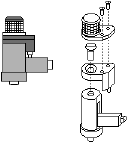 | 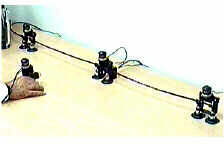 |
The probe holder is also equipped with a detector, which measures coupling between the bond inspection probe and the object under test, ensuring a continuous corresponding signal to the system and operator.
The special software MIAMAP application was created to implement data processing while performing bond testing and mapping with the ISONIC workstation. A graphic of the inspection area is presented on the screen and as the operator scans, he "paintbrushes" the area that has been scanned properly. Defects detected in the change the color being plotted and a map (C-Scan) of the defects is produced.
 | 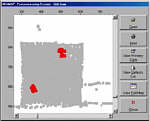 |
The inspection result can be saved on disk and then plotted as a bond map. The postprocessing features automatic measurements of defect coordinates and creates a comprehensive defects list.
The ISONIC-MIAMAP System ensures the validity of manual bond testing based on:
References:
- New defect recording system.- INSIGHT - The Journal of British Institute of Non-Destructive Testing, 1996, Vol.38, N4, p.260
- Ultrasound Imaging System. - Pat. 5524627 (USA), Published, June 11, 1996 / G.Passi
- High-Reliability Manual Ultrasonic Inspection - INSIGHT - The Journal of British Institute of Non-Destructive Testing, 1999, Vol.41, N4, p.225-231 - Cover Story, p.217 / G.Passi, M.Kritsky, Y.Shoef
- Ultrasonic Imaging System. - Pat. 5952577 (USA, Published, Sep 14, 1999) / G.Passi
- British Airways Choose ISONIC.- INSIGHT - The Journal of British Institute of Non-Destructive Testing, 2000, Vol.42, N3, p.137 - Cover Story, p.129